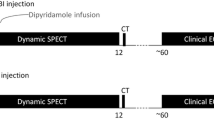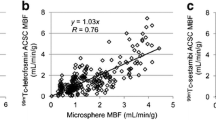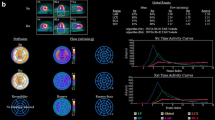Abstract
Objectives
The aim of this study was to evaluate the accuracy of myocardial blood flow (MBF) quantitation of 99mTc-Sestamibi (MIBI) single photon emission computed tomography (SPECT) compared with 13N-Ammonia (NH3) position emission tomography (PET) on the same cohorts.
Background
Recent advances of SPECT technologies have been applied to develop MBF quantitation as a promising tool to diagnose coronary artery disease (CAD) for areas where PET MBF quantitation is not available. However, whether the SPECT approach can achieve the same level of accuracy as the PET approach for clinical use still needs further investigations.
Methods
Twelve healthy volunteers (HVT) and 16 clinical patients with CAD received both MIBI SPECT and NH3 PET flow scans. Dynamic SPECT images acquired with high temporary resolution were fully corrected for physical factors and processed to quantify K1 using the standard compartmental modeling. Human MIBI tracer extraction fraction (EF) was determined by comparing MIBI K1 and NH3 flow on the HVT group and then used to convert flow values from K1 for all subjects. MIBI and NH3 flow values were systematically compared to validate the SPECT approach.
Results
The human MIBI EF was determined as [1.0-0.816*exp(−0.267/MBF)]. Global and regional MBF and myocardial flow reserve (MFR) of MIBI SPECT and NH3 PET were highly correlated for all subjects (global R2: MBF = 0.92, MFR = 0.78; regional R2: MBF ≥ 0.88, MFR ≥ 0.71). No significant differences for rest flow, stress flow, and MFR between these two approaches were observed (All p ≥ 0.088). Bland-Altman plots overall revealed small bias between MIBI SPECT and NH3 PET (global: ΔMBF = −0.03Lml/min/g, ΔMFR = 0.07; regional: ΔMBF = −0.07 − 0.06 , ΔMFR = −0.02 − 0.22).
Conclusions
Quantitation with SPECT technologies can be accurate to measure myocardial blood flow as PET quantitation while comprehensive imaging factors of SPECT to derive the variability between these two approaches were fully addressed and corrected.






Similar content being viewed by others
Abbreviations
- BMI:
-
Body mass index
- CAD:
-
Coronary artery disease
- CAG:
-
Coronary angiography
- CI:
-
Confidence interval
- DBP:
-
Diastolic blood pressure
- EF:
-
Extraction fraction
- FFR:
-
Fraction flow reserve
- HR:
-
Heart rate
- HVT:
-
Healthy volunteers
- LAD:
-
Left anterior descending
- LCX:
-
Left circumflex
- MBF:
-
Myocardial blood flow
- MFR:
-
Myocardial flow reserve
- MIBI:
-
99mTc-Sestamibi
- NH3:
-
13N-Ammonia
- PET:
-
Positron emission tomography
- RCA:
-
Right coronary artery
- RMBF:
-
Rest MBF
- SBP:
-
Systolic blood pressure
- SD:
-
Standard deviation
- SMBF:
-
Stress MBF
- SPECT:
-
Single photon emission computed tomography
- VOI:
-
Volume of interest
References
Gould KL, Johnson NP, Bateman TM, et al. Anatomic versus physiologic assessment of coronary artery disease: guiding management decisions using positron-emission tomography as a physiologic tool. J Am Coll Cardiol. 2013;62:1639–53.
Johnson NP, Gould KL. Integrating noninvasive absolute flow, coronary flow reserve, and ischemic thresholds into a comprehensive map of physiological severity. JACC Cardiovasc Imaging. 2012;5:430–40.
Fiechter M, Ghadri JR, Gebhard C, et al. Diagnostic value of 13Nammonia myocardial perfusion PET: added value of myocardial flow reserve. J Nucl Med. 2012;53:1230–4.
Ziadi MC, Dekemp RA, Williams K, et al. Does quantification of myocardial flow reserve using rubidium-82 positron emission tomography facilitate detection of multivessel coronary artery disease? J Nucl Cardiol. 2012;19:670–80.
Murthy VL, Naya M, Foster CR, et al. Improved cardiac risk assessment with noninvasive measures of coronary flow reserve. Circulation. 2011;124:2215–24.
Farhad H, Dunet V, Bachelard K, et al. Added prognostic value of myocardial blood flow quantitation in rubidium-82 positron emission tomography imaging. Eur Heart J Cardiovasc Imaging. 2013;14:1203–10.
Ziadi MC, Dekemp RA, Williams KA, et al. Impaired myocardial flow reserve on rubidium-82 positron emission tomography imaging predicts adverse outcomes in patients assessed for myocardial ischemia. J Am Coll Cardiol. 2011;58:740–8.
Johnson NP, Kirkeeide RL, Gould KL. Is discordance of coronary flow reserve and fractional flow reserve due to methodology or clinically relevant coronary pathophysiology? JACC Cardiovasc Imaging. 2012;5:193–202.
van Lavieren MA, van de Hoef TP, Sjauw KD, et al. How should I treat a patient with refractory angina and a single stenosis with normal FFR but abnormal CFR? EuroIntervention. 2015;11:125–8.
Nakazato R, Heo R, Leipsic J, et al. CFR and FFR assessment with PET and CTA: strengths and limitations. Curr Cardiol Rep. 2014;16:484.
Ben-Haim S, Murthy VL, Breault C, et al. Quantification of Myocardial Perfusion Reserve Using Dynamic SPECT Imaging in Humans: A Feasibility Study. J Nucl Med. 2013;54:873–9.
Klein R, Hung GU, Wu TC, et al. Feasibility and operator variability of myocardial blood flow and reserve measurements with 99mTc-sestamibi quantitative dynamic SPECT/CT imaging. J Nucl Cardiol. 2014;6:1075–88.
Hsu B, Chen FC, Wu TC, et al. Quantitation of myocardial blood flow and myocardial flow reserve with 99mTc-sestamibi dynamic SPECT/CT to enhance detection of coronary artery disease. Eur J Nucl Med Mol Imaging. 2014;41:2294–306.
Shrestha U, Sciammarella M, Alhassen F, et al. Measurement of absolute myocardial blood flow in humans using dynamic cardiac SPECT and (99m)Tc-tetrofosmin: Method and validation. J Nucl Cardiol 2015.
Ben Bouallègue F, Roubille F, Lattuca B, et al. SPECT Myocardial Perfusion Reserve in Patients with Multivessel Coronary Disease: Correlation with Angiographic Findings and Invasive Fractional Flow Reserve Measurements. J Nucl Med. 2015;56:1712–7.
Shiraishi S, Sakamoto F, Tsuda N, et al. Prediction of left main or 3-vessel disease using myocardial perfusion reserve on dynamic thallium-201 single-photon emission computed tomography with a semiconductor gamma camera. Circ J. 2015;79:623–31.
Apostolopoulos DJ, Kaspiri A, Spyridonidis T, et al. Assessment of absolute Tc-99m tetrofosmin retention in the myocardium as an index of myocardial blood flow and coronary flow reserve by gated-SPECT/CT: a feasibility study. Ann Nucl Med. 2015;29:588–602.
Petretta M, Storto G, Pellegrino T, et al. Quantitative Assessment of Myocardial Blood Flow with SPECT. Prog Cardiovasc Dis. 2015;57:607–14.
Garcia EV. Are SPECT measurements of myocardial blood flow and flow reserve ready for clinical use? Eur J Nucl Med Mol Imaging. 2014;41:2291–3.
Bateman TM, Heller GV, McGhie AI, et al. Diagnostic accuracy of rest/stress ECG-gated Rb-82 myocardial perfusion PET: comparison with ECG-gated Tc-99m sestamibi SPECT. J Nucl Cardiol. 2006;13:24–33.
Flotats A, Bravo PE, Fukushima K, et al. 82Rb PET myocardial perfusion imaging is superior to 99m Tc-labelled agent SPECT in patients with known or suspected coronary artery disease. Eur J Nucl Med Mol Imaging. 2012;39:1233–9.
Chatal JF, Rouzet F, Haddad F, et al. Story of Rubidium-82 and Advantages for Myocardial Perfusion PET Imaging. Front Med (Lausanne). 2015;2:65.
Hutchins GD, Caraher JM, Raylman RR. A region of interest strategy for minimizing resolution distortions in quantitative myocardial PET studies. J Nucl Med. 1992;33:1243–50.
Pan XB, Declerck J. White Paper: Validation syngo.PET Myocardial Blood Flow. Hoffman Estates, IL: Siemens Medical Solutions; 2011:1–17.
Pan XB, Schindler TH, Ratib O, et al. Effect of reorientation on myocardial blood flow estimation from dynamic 13NH3PET imaging. IEEE Nucl Sci Symp Med Imaging Conf Rec. 2009;1:3715–7.
Leppo JA, Meerdink DJ. Comparison of the myocardial uptake of a technetium-labeled isonitrile analogue and thallium. Circ Res. 1989;65:632–9.
Klein R, Beanlands RS. deKemp RA. Quantification of myocardial blood flow and flow reserve: Technical aspects. J Nucl Cardiol. 2010;17:555–70. Review.
Czernin J, Muller P, Chan S. Influence of age and hemodynamics on myocardial blood flow and flow reserve. Circulation. 1993;88:62–9.
Nagamachi S, Czernin J, Kim AS, et al. Reproducibility of measurements of regional resting and hyperemic myocardial blood flow assessed with PET. J Nucl Med. 1996;10:1626–31.
Lortie M, Beanlands RS, Yoshinaga K, et al. Quantification of myocardial blood flow with 82Rb dynamic PET imaging. Eur J Nucl Med Mol Imaging. 2007;34:1765–74.
Prior JO, Allenbach G, Valenta I, et al. Quantification of myocardial blood flow with 82Rb positron emission tomography: clinical validation with 15O-water. Eur J Nucl Med Mol Imaging. 2012;39:1037–47.
Chen LC, Lin CY, Chen IJ, et al. SPECT Myocardial Blood Flow Quantitation Concludes Equivocal Myocardial Perfusion SPECT Studies to Increase Diagnostic Benefits. Clin Nucl Med. 2016;41:e60–2.
Acknowledgments
This research was supported by government research grants from Ministry of Science and Technology, Taiwan (grant numbers: NSC 102-2623-E-758-001-NU and NSC 101-2623-E-075004-NU).
Author information
Authors and Affiliations
Corresponding authors
Ethics declarations
Ethical Approval
All procedures performed in studies involving human participants were in accordance with the ethical standards of the institutional and/or national research committee and with the 1964 Helsinki declaration and its later amendments or comparable ethical standards.
Conflict of Interest
All authors declare that they have no conflict of interest.
Additional information
Bailing Hsu and Guang-Uei Hung contributed equally to this work.
Rights and permissions
About this article
Cite this article
Hsu, B., Hu, LH., Yang, BH. et al. SPECT myocardial blood flow quantitation toward clinical use: a comparative study with 13N-Ammonia PET myocardial blood flow quantitation. Eur J Nucl Med Mol Imaging 44, 117–128 (2017). https://doi.org/10.1007/s00259-016-3491-5
Received:
Accepted:
Published:
Issue Date:
DOI: https://doi.org/10.1007/s00259-016-3491-5




